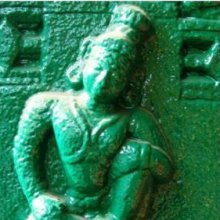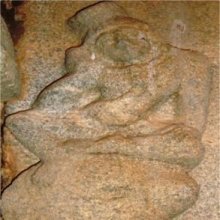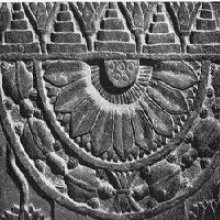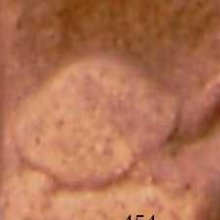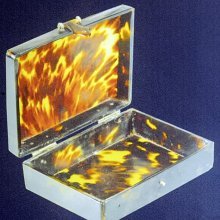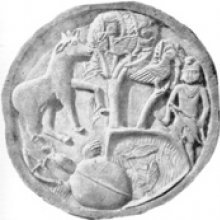Tortoise: 2 definitions
Introduction:
Tortoise means something in Hinduism, Sanskrit. If you want to know the exact meaning, history, etymology or English translation of this term then check out the descriptions on this page. Add your comment or reference to a book if you want to contribute to this summary article.
Images (photo gallery)
(+12 more images available)
In Hinduism
Natyashastra (theatrics and dramaturgy)
Source: Shodhganga: Elements of Art and Architecture in the Trtiyakhanda of the Visnudharmottarapurana (natya)The Tortoise is denoted by the Sanskrit term Kūrma, whereas Kūrmāvatāra refers to one the Daśāvatāra (“ten incarnations”) (of Lord Viṣṇu) to which are assign various hand gestures (in Indian Dramas), according to the Viṣṇudharmottarapurāṇa, an ancient Sanskrit text which (being encyclopedic in nature) deals with a variety of cultural topics such as arts, architecture, music, grammar and astronomy.—The word kūrma means tortoise. According to the Viṣṇudharmottarapurāṇa, to show the kūrmāvatāra, the patāka hand should be curved downward.

Natyashastra (नाट्यशास्त्र, nāṭyaśāstra) refers to both the ancient Indian tradition (shastra) of performing arts, (natya—theatrics, drama, dance, music), as well as the name of a Sanskrit work dealing with these subjects. It also teaches the rules for composing Dramatic plays (nataka), construction and performance of Theater, and Poetic works (kavya).
Shilpashastra (iconography)
Source: Shodhganga: Elements of Art and Architecture in the Trtiyakhanda of the Visnudharmottarapurana (shilpa)1) Tortoises in a painting follow specific guidelines in the ancient Indian tradition of Painting (citra), according to the Viṣṇudharmottarapurāṇa, an ancient Sanskrit text which (being encyclopedic in nature) deals with a variety of cultural topics such as arts, architecture, music, grammar and astronomy.—According to the Viṣṇudharmottarapurāṇa, a picture having water or so to say showing water sources should be drawn with numerous fishes, tortoises and aquatic animals. [...] Thus, the Viṣṇudharmottarapurāṇa addresses various elements of nature, such as tortoises, since painting has much connection with time, mood and activity.
2) The Tortoise is associated with the image of Yamunā, whose iconography is described in the Viṣṇudharmottarapurāṇa.—The images of Gaṅgā and Yamunā are also placed in the right and left side of the image of Varuṇa respectively. The Viṣṇudharmottarapurāṇa states that the image of Yamunā should be placed on a tortoise and also have cāmara in her hand. Thus it is clear that the Viṣṇudharmottarapurāṇa offers a great field of knowledge regarding the nuances of Indian art of Image making [e.g., the tortoise] during 10th–11th century A.D.

Shilpashastra (शिल्पशास्त्र, śilpaśāstra) represents the ancient Indian science (shastra) of creative arts (shilpa) such as sculpture, iconography and painting. Closely related to Vastushastra (architecture), they often share the same literature.
See also (Relevant definitions)
Partial matches: Tortoise, Te.
Query error!
Full-text (+435): Kurma, Kacchapa, Kamatha, Akupara, Kaurma, Kurmanadi, Parivartta, Dauleya, Kurmavatara, Gudhanga, Dudi, Duli, Kuhupala, Palvalavasa, Krodanka, Mahaka, Caturgati, Pancagupta, Kathinaprishtha, Kacchapi.
Relevant text
Search found 232 books and stories containing Tortoise, The tortoise; (plurals include: Tortoises, The tortoises). You can also click to the full overview containing English textual excerpts. Below are direct links for the most relevant articles:
Hitopadesha (English translation) (by Sir Edwin Arnold)
Chapter 2 - The Story of the Tortoise and the Geese < [Book Four - Peace]
Chapter 4 - The Story Of The Unabashed Wife < [Book Four - Peace]
Chapter 5 - The Story of the Herons and the Mongoose < [Book Four - Peace]
Jataka tales [English], Volume 1-6 (by Robert Chalmers)
Jataka 273: Kacchapa-jātaka < [Book III - Tika-Nipāta]
Jataka 178: Kacchapa-jātaka < [Book II - Dukanipāta]
Jataka 215: Kacchapa-jātaka < [Book II - Dukanipāta]
Manusmriti with the Commentary of Medhatithi (by Ganganatha Jha)
Verse 1.44 < [Section XXV - The Viviparous, Oviparous, Sweat-born and Vegetable Beings]
Verse 1.45 < [Section XXV - The Viviparous, Oviparous, Sweat-born and Vegetable Beings]
Verse 5.17 < [Section II - Objectionable Food]
Satapatha-brahmana (by Julius Eggeling)
Kanda VII, adhyaya 5, brahmana 1 < [Seventh Kanda]
Kanda X, adhyaya 5, brahmana 5 < [Tenth Kanda]
Introduction to volume 2 (kāṇḍa 3-4) < [Introductions]
Brihad Bhagavatamrita (commentary) (by Śrī Śrīmad Bhaktivedānta Nārāyana Gosvāmī Mahārāja)
Verse 2.4.142-144 < [Chapter 4 - Vaikuṇṭha (the spiritual world)]
Verse 2.4.106-107 < [Chapter 4 - Vaikuṇṭha (the spiritual world)]
Verse 2.1.63 < [Chapter 1 - Vairāgya (renunciation)]
Vaishnava Myths in the Puranas (by Kum. Geeta P. Kurandwad)
The concept of Kurma-Avatara (incarnation) < [Chapter 4 - Significance of Vaishnava Myths]
The concept of Nrisimha-Avatara (incarnation) < [Chapter 4 - Significance of Vaishnava Myths]
Myths of Tirthankaras < [Chapter 2 - Varieties of Myths]
